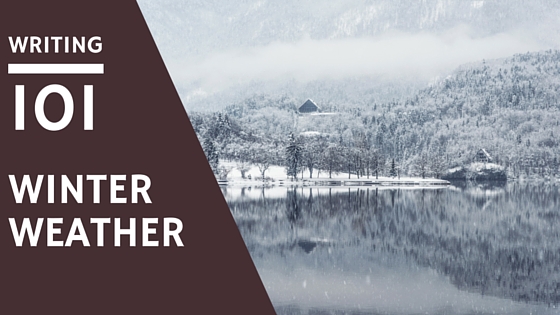Like so many other people affected by the recent extreme weather, I had plenty of time to consider snow. And as with so many other things that I consider, I started reading about it. Yes, Elmore Leonard is adamant that you never start a book with the weather—but that is not to say weather is taboo in your story. Your task as a writer is to make weather interesting. As an exercise, consider the following snow-related facts, and how you might fit them into a story in a way that seems natural, preferably relevant to the plot!

Chionophobia is a persistent fear of snow, especially being trapped by snow. Winter cold kills more than twice as many Americans as summer heat does. Maybe your character has a reason to move to Key West!
Some parts of Antarctica have had no rain or snow for two million years. Also, snow has never been reported in Key West, FL.
On average, an inch of rain makes 10 inches of snow.
Skiing was introduced to Switzerland by Sir Arthur Conan Doyle in 1893.
Handschuhschneeballwerfer is German slang for “coward.” It means someone who wears gloves to throw snowballs.
A snowflake that falls on glacier in central Greenland can take 200,000 years to reach the sea.
Conventional wisdom holds that all snowflakes have 6 sides. But according to the Huffington Post, there are triangles, hourglasses, spools of thread, needles, hollow columns, dendrites, prisms, and flat plates as well. Asymmetrical snowflakes are more common than symmetrical ones. Shapes vary by temperature and moisture in the clouds. What sort of person would care about the shape of snowflakes?
It’s a myth that no two snowflakes are exactly the same; in 1988, two identical snow crystals came from a storm in Wisconsin. But according to physicists, complex snowflakes are indeed unique.
According to The Guinness Book of World Records, the world’s largest snowflake was reported to be 15 inches across and 8 inches thick. While witnesses said the flakes were “larger than milk pans,” these claims have not been substantiated.
Snow isn’t white; it’s actually clear and colorless. The appearance of white results from absorbing sunlight uniformly over the wavelengths of visible light.
Sometimes snow doesn’t appear white. Orange snow fell over Siberia in 2007. Deep snow can appear blue. Snow can also appear pink (watermelon snow). Snow in high alpine areas and the coastal polar regions contains fresh-water algae that have a red pigment that tints the surrounding snow. Perhaps your character made snowcream with pink snow and all who ate it got sick from the algae.
Each winter in the US, at least 1 septillion ice crystals fall from the sky—that’s 1 with 24 zeros. The average snowflake falls at a speed of 3.1 mph.
An average snowflake is made up of 180 billion molecules of water.
Besides snowflakes, frozen precipitation can take the form of hail, graupel (snow pellets), or sleet.
The most snow ever recorded in a 24-hour period in the US was 75.8 inches (Silver Lake, CO, 1921). The second most fell in one calendar day, 63 inches, in Georgetown, CO, 1913. In 1959, a single snowstorm in Mt. Shasta dropped as much as 15.75 feet of snow in that California region.
Mt. Baker ski area in Washington State has the world record for snowfall: 1,140 inches in the 1998-99 winter season (about 95 feet). Who would be happy about that?
80% of the freshwater on earth is frozen as ice or snow, accounting for 12% of the earth’s surface.
A blizzard is when you can’t see for 1/4 mile, the winds are 35 mph or more, and the storm lasts at least 3 hours.
People buy more cakes, cookies, and candies than any other food when a blizzard is forecast. And I thought it was bread and milk! What would your character stock up? Wine? Beans? Oatmeal? Dog biscuits? Toilet paper?
The US averages 105 snow storms per year, typically lasting 2-5 days and affecting multiple states.
An igloo can be more than 100 degrees warmer inside than outside—and they’re warmed entirely by body heat.
According to wikipedia, the Eskimo-Aleut languages have about the same number of distinct word roots referring to snow as English does, but these languages allow more variety as to how those roots can be modified in forming a single word. This issue is still debated.
Snowboarders and skiers often distinguish different types of snow by labels such as mashed potatoes, pow pow, champagne, cauliflower, sticky, or dust on crust.
Nova Scotia holds the record for the most snow angels ever made simultaneously in multiple locations: 22,022 in 130 locations in 2011. Bismarck, North Dakota holds the record for the most snow angels made simultaneously in one place: 8,962 in 2007.
The largest snowball fight on record involved 5,834 fighters in Seattle on January 12, 2013.
The largest snowman ever recorded was 113 feet 7 inches, in Bethel, ME. Perhaps your character wants to break that record.
Rochester, NY, is the snowiest city in the US, averaging 94 inches of snow a year.
In 1992, the Common Council of Syracuse, NY, passed a decree that any more snow before Christmas Eve was illegal. Just two days later, they had more snow. But what’s the story there?







